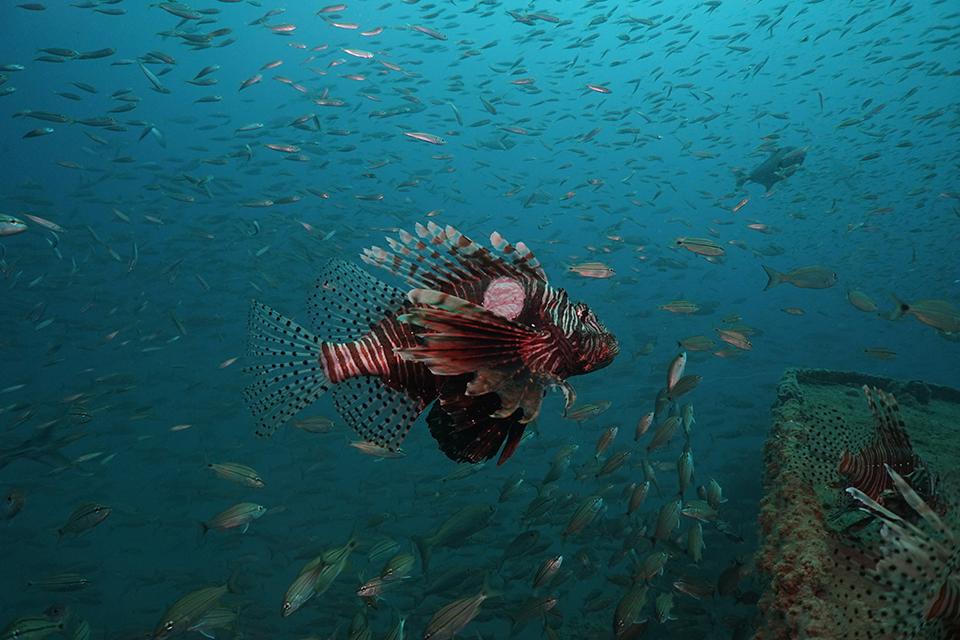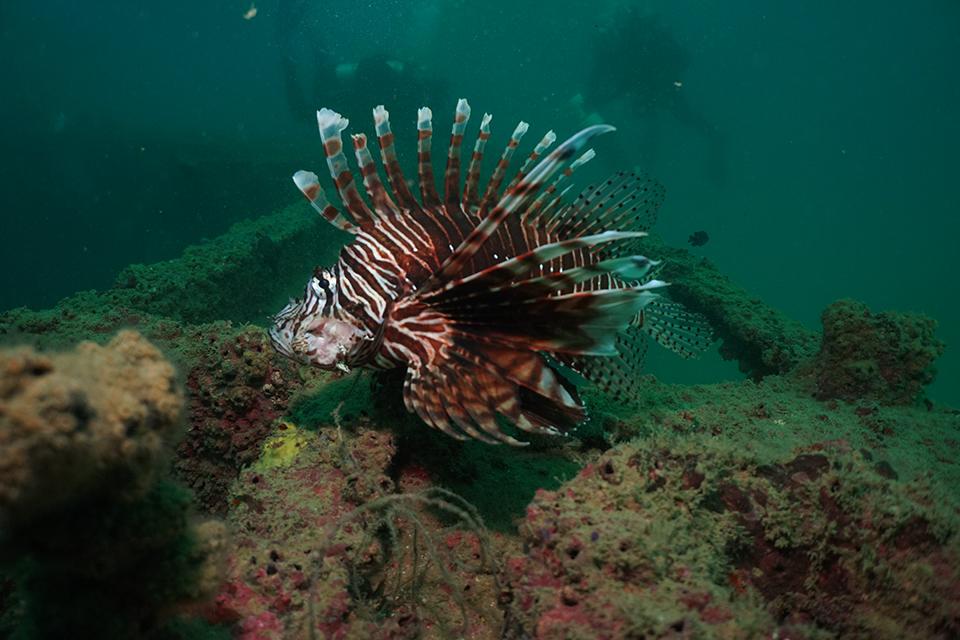
Invasive lionfish with a lesion / Photo courtesy of Alex Fogg.
The Arrival of Lionfish
Lionfish. Impossibly beautiful, incredibly invasive.
Arriving on Florida's shores in the 20th century, the initial lionfish population invasion probably resulted from an accidental or intentional release from a hobbyist fish tank. Since then, their numbers have exploded, stretching across the Atlantic and Gulf coasts. Reef species, lionfish cruise these aquatic habitats for prey, both outcompeting native fish and gobbling up their future generations. Because lionfish are rarely caught on hook and line, they are most effectively removed from the environment by trained divers.
In recent years, many lionfish have been afflicted with skin lesions that do not affect native fish. Will the lesions impact their population numbers as a whole? Park staff and lionfish experts are looking into that question.
Alex Fogg, the marine resource coordinator for Okaloosa County and a commercial lionfisherman, frequently dives to harvest and study the invasive species. “Because lionfish have little to no native predators, they have nothing to fear,” he explains. “So when a diver approaches a lionfish, oftentimes they just sit there. Even when you start harvesting them, the rest of the lionfish on the reef just sit there and wait their turn.”
Lionfish in Biscayne National Park
Biscayne National Park in South Florida has hired biologists to monitor and study the lionfish within the national park's waters. First observed in 2009, the fish have been a management challenge ever since.
"We maintain an active removal program, using pole spears to remove them," says Dr. Vanessa McDonough, fishery and wildlife biologist at Biscayne. "Park staff have documented the removal of over 8,000 fish since we began actively removing them."
She continues in an email, "In addition to the removals, we have partnered with several universities and researchers to complete studies to help our understanding of the invasion from a variety of perspectives (community impacts, recolonization rate, reproductive patterns, behavior, dietary studies etc)."
As in many areas of Florida, lesions have appeared on lionfish in Biscayne, though Dr. McDonough herself has observed only a handful. Still, staff are watching closely, as "lionfish with infections (lesions) could have altered success (predation, reproduction, competition), different behaviors and habitat choices, and/or decreased life span, all of which could affect the invasion and how we manage it."

Invasive lionfish with a lesion / Photo courtesy of Alex Fogg
What You Can Do
Lionfish sport venomous spines that divers and those preparing the filets must be wary of, but the lionfish themselves are quite delicious. Importantly, venomous species have protrusions that can poke or sting you; poisonous species are harmful to eat. Because lionfish are venomous and not poisonous, they are safe to consume.
Though most of us cannot fish for them without diving experience, visitors and locals alike can order this invasive species from grocery stores and restaurants. "By ordering lionfish," Dr. McDonough explains, "the consumer shifts the demand from native species (many of which are already considered to be in decline) to the invasive species. More market demand could increase commercial efforts to target this species while simultaneously reducing efforts on the native species."
There are no reports of human illness stemming from the lionfish lesions, Fogg says. The filets are so mild that even high school students - known for picky pallets - enjoyed them for breakfast during an invasive species lesson in a Northwest Florida high school.
To combat the problem, some environmental managers have begun to innovate ways to curb lionfish expansion. “Specifically,” Fogg says, “Lionfish traps have showed a lot of promise, and there is a great deal of work being done collaboratively with University of Florida, NOAA, and Okaloosa County to determine the efficacy of these traps Recent tests have proved promising but future testing is still necessary."
While the lesions may slow population growth, ordering lionfish at restaurants and supermarkets increases incentives to clear them from reefs, and better trapping mechanisms increase harvests. Still, the best way to prevent invasive species from hurting the natural environment is preventing their release in the first place. McDonough concludes: "Everyone can help by being responsible pet owners and never intentionally releasing any unwanted aquarium specimen (or any other pet) into the wild."



Comments
Too bad the lionfish are invasive, as they're quite eye-catching.